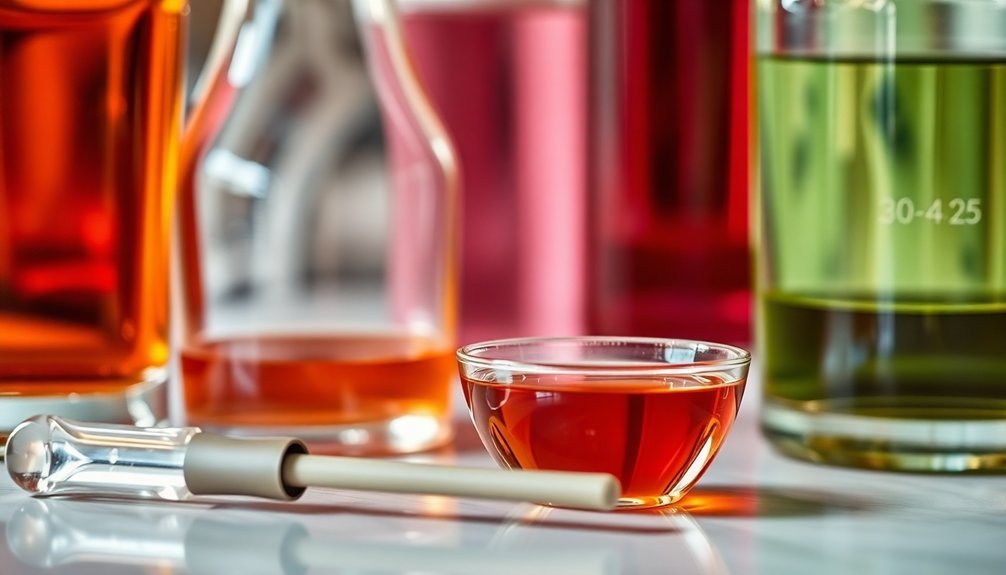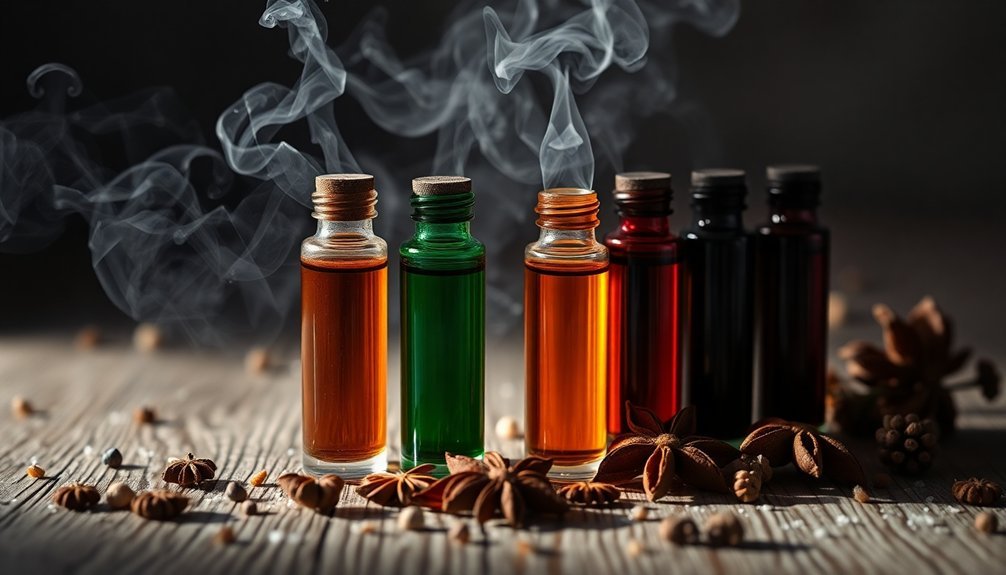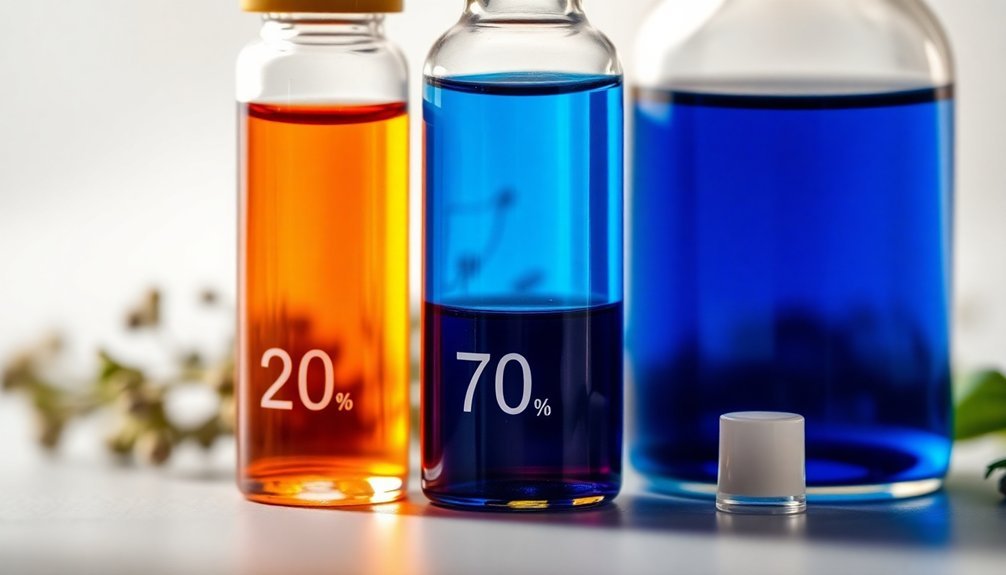You'll find seven proven ratios to create perfect perfumes: the classic 30-45-25 for traditional scents, balanced 20-50-30 for modern blends, bright 40-55-5 for summer fragrances, rich 25-50-25 for winter warmth, natural 35-50-15 for harmonious compositions, professional 20-70-10 for signature scents, and the simple three-drop equal parts method for beginners. Each ratio offers unique characteristics to achieve your desired fragrance profile, and these time-tested formulas reveal endless creative possibilities.
The Classic 30-45-25 Perfume Ratio

The legendary 30-45-25 ratio serves as a foundational blueprint for creating well-balanced perfumes.
You'll find that this classic proportion divides your fragrance into three distinct layers: 30% top notes, 45% middle notes, and 25% base notes. Starting with a 1:1 drop ratio allows you to test and adjust your blend before committing to larger amounts.
Your top notes, like bergamot and sweet orange, will create that essential first impression but evaporate quickly.
The heart of your perfume lies in the middle notes, where lavender and rose geranium form the fragrance's main character, making up the largest portion at 45%.
Finally, you'll want to anchor your blend with 25% base notes, using ingredients like ylang ylang or cedarwood atlas to provide lasting power and depth.
While you can adjust these percentages for different effects, this ratio guarantees your fragrance maintains a harmonious evolution from first spritz to final dry-down.
Balanced Harmony: The 20-50-30 Formula
Perfumers often gravitate toward the 20-50-30 formula as a modern alternative to traditional ratios. This approach alters the classic blend by adjusting the proportions to create a more middle-note dominant fragrance.
The 30/50/20 rule provides a time-tested foundation for achieving aromatic harmony in essential oil blending. You'll want to begin with small test batches using fragrance strips. For a 10-drop blend, start by combining 2 drops of base notes, followed by 5 drops of middle notes, and finish with 2 drops of top notes.
You can mix multiple oils within each note category while maintaining these ratios. For example, you might split your middle notes between two different floral oils.
Let your blend mature for several weeks to see how it evolves. When you're satisfied, dilute the final blend in carrier oil at a 20:80 ratio for safe application.
Light and Fresh: 40-55-5 Summer Blend

You'll find that summer fragrances come alive when you lead with bright citrus top notes at 5%, allowing them to dance above a substantial 55% floral heart of your blend.
The middle notes create a perfect backdrop for the fresh opening while being supported by a strong 40% base of grounding woods and earthy elements. Using a mini funnel helps ensure precise measurements when adding these carefully calculated ratios of essential oils.
Your summer perfume will feel airy yet anchored, perfectly capturing the season's light and breezy character.
Fresh Citrus Dominance Mix
Creating a vibrant summer fragrance starts with understanding the 40-55-5 ratio, where citrus notes dominate at 40%, middle notes comprise 55%, and base notes anchor at just 5%.
You'll want to combine bright citrus oils like bergamot, lemon, and grapefruit for the top notes, while using floral or herbal elements like lavender and geranium for the substantial middle.
A touch of sandalwood or vetiver provides a subtle base that won't overpower the fresh profile.
- Let the zesty burst of lime and bergamot awaken your senses
- Experience the calming embrace of lavender and geranium at the heart
- Feel transported to a sun-drenched citrus grove in full bloom
- Discover how the whisper of woody base notes grounds your summer story
Remember to test your blend on separate strips and adjust proportions based on each oil's strength.
Floral Heart Balance
While citrus-dominant blends offer vibrant energy, a floral heart balance brings an elegant sophistication to summer fragrances. You'll want to aim for a lighter distribution of 40% middle notes, 55% top notes, and 5% base notes to achieve that perfect summer blend.
To create harmony between your floral and fresh notes, consider these essential pairings:
| Fresh Note | Floral Heart |
|---|---|
| Lemon | Jasmine |
| Grapefruit | Gardenia |
| Bergamot | Lavender |
| Orange | Ylang-ylang |
| Lime | Rose |
Add your blending notes drop by drop, using lavender or bergamot to bridge the gap between top and heart notes. Remember to keep your base notes minimal – just enough to fix the scent without weighing it down. You'll know you've achieved the right balance when your fragrance feels light, fresh, and perfectly suited for summer wear.
Subtle Anchoring Notes
Subtle anchoring notes form the delicate foundation of a summer fragrance, requiring careful selection to maintain the blend's airy character.
You'll want to choose light woods and gentle musks that won't overwhelm your bright top notes and floral hearts. For a perfect summer blend, aim for a 40-55-5 ratio, where your base notes make up just 5% of the total composition.
- Let cedarwood's clean, crisp undertones cradle your blend like a gentle summer breeze.
- Embrace white musk's ethereal whisper to add sophistication without weight.
- Incorporate a touch of vanilla for warmth that doesn't overpower.
- Trust sandalwood's subtle sweetness to ground your fragrance naturally.
Use the drop-by-drop method when adding these anchoring notes, testing frequently to maintain your blend's summery lightness.
Deep and Rich: 25-50-25 Winter Mix

For winter fragrances that demand lasting power, the 25-50-25 ratio delivers a richer, deeper blend perfect for cold weather.
You'll want to adjust the traditional 30-50-20 formula by reducing top notes and increasing base notes for a more substantial scent that persists through chilly days.
In a 20-drop blend, you'll use 5 drops of top notes like bergamot, 10 drops of middle notes such as clary sage, and 5 drops of base notes like cedarwood atlas.
This modified ratio creates a warmer, more grounding fragrance that won't dissipate quickly in cold temperatures.
When mixing your winter blend, combine it with carrier oil at a 20% concentration, and consider adding a few drops of IPA to enhance longevity.
Let your blend mature for 2-3 weeks to achieve its full potential.
Natural Perfume's 35-50-15 Golden Ratio
The golden ratio's influence on perfumery reaches its peak in the natural 35-50-15 blend, offering a mathematically harmonious approach to fragrance creation.
You'll find this ratio distributes your fragrance notes perfectly: 35% for the initial impact of top notes like bergamot and black pepper, 50% for the enduring heart notes like lavender and rosemary, and 15% for the grounding base notes such as jasmine and vetiver.
- Experience the exhilarating burst of citrus as top notes dance on your skin
- Feel the gentle embrace of middle notes wrapping around you like a silk scarf
- Surrender to the deep, rich base notes that anchor your signature scent
- Marvel at how these proportions create a perfume that evolves beautifully throughout the day
Let your blend mature for 2-3 weeks in jojoba oil for ideal results.
The Professional 20-70-10 Signature Blend

Professional perfumers embrace a sophisticated 20-70-10 signature blend that revolutionizes traditional fragrance composition.
This unique ratio allocates 20% to vibrant top notes like bergamot and ginger, 70% to the heart notes including rosemary and lavender, and 10% to lasting base notes such as vanilla and patchouli.
You'll find this blend creates exceptional durability, as the substantial middle note content sustains the fragrance while top notes dissipate.
To achieve this ratio, start by adding base notes, followed by middle notes, and finish with top notes, blending drop-by-drop for precise balance.
Remember to take into account your skin chemistry when testing.
For small skin areas, you can use 10-50% essential oil concentrations, while larger areas require 2-3%.
Adding jojoba oil helps stabilize the scent and extends its longevity.
Simple Three-Drop Equal Parts Method
You'll start the Three-Drop Equal Parts Method by adding one drop each of your chosen base, middle, and top notes to create a foundational blend.
After recording each drop in your notebook, test the blend on a fragrance strip to assess how the scents work together.
If needed, you can adjust the ratios by adding single drops of specific notes until you've achieved your desired fragrance profile.
Starting The Equal Method
Starting your perfume-making journey with the equal parts method offers a straightforward approach to fragrance blending. Using the 1:1:1 ratio, you'll combine your top, middle, and base notes drop by drop, creating a balanced foundation for your signature scent.
This method works well with stock bottles and allows you to adjust proportions as you develop your skills.
- Feel the excitement as you select your first three essential oils – one from each note category.
- Experience the magic of transformation as you blend one drop at a time, swirling gently.
- Watch with anticipation as your creation settles and matures over several days.
- Savor the satisfaction of recording your blend's recipe in your perfume journal.
Remember to let your blend rest for a few days, allowing the chemical compounds to interact and develop their full aromatic potential.
Making Perfect Drop Adjustments
While mastering the art of perfumery requires practice, the simple three-drop equal parts method offers an accessible starting point for precise fragrance blending.
Start by adding three drops each of your chosen top, middle, and base notes into a small blending bottle. Let the mixture sit for at least 24 hours to allow the scents to meld together naturally.
You'll want to evaluate the blend after this resting period to determine if any adjustments are needed. If you find the fragrance needs fine-tuning, add one drop at a time of whichever note requires strengthening.
Remember to record each addition in your notebook. This methodical approach helps you maintain control over the blend's evolution while developing your understanding of how different notes interact with each other.
Frequently Asked Questions
How Long Should I Let My Perfume Blend Mature Before Using It?
You'll want to let your perfume mature for at least 2-7 days for simple blends, or up to several months for complex ones. The longer you wait, the smoother and more balanced your fragrance will become.
Can I Mix Different Fragrance Families in One Perfume Blend?
Yes, you can mix different fragrance families! Try using techniques like the Neighbor or Triangle method to create harmonious blends. Oriental with woody, or floral with citrus notes work especially well together.
What's the Best Temperature for Storing My Blended Perfumes?
Store your blended perfumes at a consistent temperature between 15-20°C (59-68°F). You'll want to keep them in a cool, dark place away from direct sunlight, radiators, and bathroom humidity.
How Can I Test My Perfume's Longevity Before Making Larger Batches?
You can test your perfume's longevity through accelerated stability testing, using small samples at elevated temperatures. Apply test batches to your skin and monitor how long they last throughout the day.
Should I Adjust Ratios Differently When Using Synthetic Versus Natural Fragrances?
Yes, you'll need to adjust ratios with synthetics versus naturals. Synthetic fragrances typically need less product due to their consistent evaporation rates, while natural ingredients often require higher concentrations for similar effects.
In Summary
You've now explored seven proven fragrance ratios that'll transform your perfume-making journey. Whether you're drawn to the classic 30-45-25 or prefer the light summer blend, these formulas serve as your starting point. Don't be afraid to tweak these ratios to match your vision. Remember, perfumery is both science and art – trust your nose, experiment with confidence, and you'll create scents that are uniquely yours.





Leave a Reply